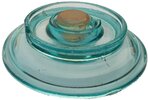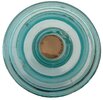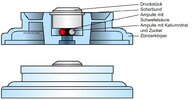Bellifortis
Well-Known Member
I would like to start this discussion with a question : What does SF mean or stand for ? Also my research into these is lasting already for many years, I seem to come up with only small bits of information off and on in many different publications that leave most questions unanswered. The No.s I could identify is : D.Z. SF 1 (Druck Znder) sometimes also written as To.Mi.Z. SF 1 (Topf Minen Znder). This is the all Glasfuze with 2 Ampules, one containing a clear liquid, the other a silver coloured liquid). Does anybody have any background information on its development and the chemical constitution I have never seen mentioned in EOD handbooks of any age ? Most this fuzes work by hypergolic reaction mechanisms.
E.Z. SF 3 ( Entlastungsznder ): Made from Bakelit 79 x 76mm, a rare fuze, but some, or parts of it have been on the market recently.
D.Z. SF 5 Type A also called Buck fuze :with vertical Glasampule, Type B : with horizontal Glasampule in cottonwool. May be one of the french members can shed some light on these, as I read here in other posts that the office and production facilities of Mr.Buck were in Paris.
The other fuze used in the Glassmine is the Hebelznder SM 4 ( I suspect that SM stands for Schtzen Mine) also called Schuko Igniter (I don't know why) and the Hebelznder 44 of which a nice example was just shown a few days back from a member in France.
The mine A 200 Senftopf (Mustardpot) with a chemical fuze with 1 glasampule ( for which I dont know the designation No.), probably based on the hypergolic reaction pair Potassium permanganate / H2SO4. The highest No. I ever read about is the S.Kst.Mi.Z. SF 18 (Schtzen Ksten Mine) with the fuze integrated in the glasplate, of which I never even have seen a picture and don't know if it is the same as Glasmine 43 (W). What developments stand for all the missing No.s between 1 and 18 ? Questions, questions only questions. Who has some answers ?
Greetings,
Bellifortis.
E.Z. SF 3 ( Entlastungsznder ): Made from Bakelit 79 x 76mm, a rare fuze, but some, or parts of it have been on the market recently.
D.Z. SF 5 Type A also called Buck fuze :with vertical Glasampule, Type B : with horizontal Glasampule in cottonwool. May be one of the french members can shed some light on these, as I read here in other posts that the office and production facilities of Mr.Buck were in Paris.
The other fuze used in the Glassmine is the Hebelznder SM 4 ( I suspect that SM stands for Schtzen Mine) also called Schuko Igniter (I don't know why) and the Hebelznder 44 of which a nice example was just shown a few days back from a member in France.
The mine A 200 Senftopf (Mustardpot) with a chemical fuze with 1 glasampule ( for which I dont know the designation No.), probably based on the hypergolic reaction pair Potassium permanganate / H2SO4. The highest No. I ever read about is the S.Kst.Mi.Z. SF 18 (Schtzen Ksten Mine) with the fuze integrated in the glasplate, of which I never even have seen a picture and don't know if it is the same as Glasmine 43 (W). What developments stand for all the missing No.s between 1 and 18 ? Questions, questions only questions. Who has some answers ?
Greetings,
Bellifortis.




